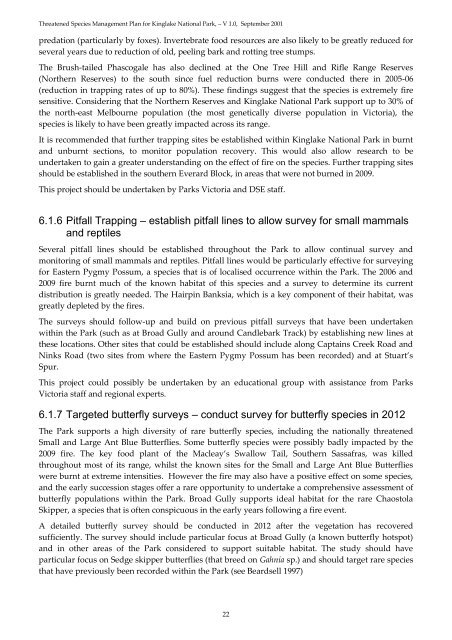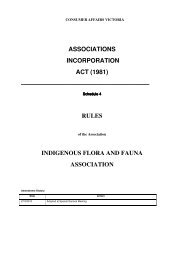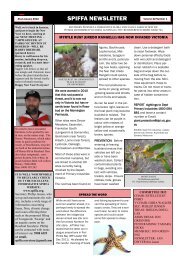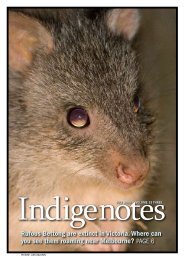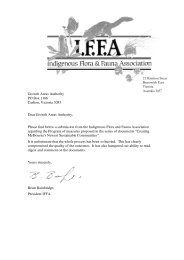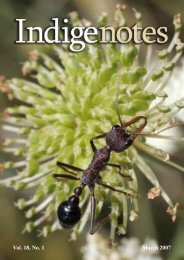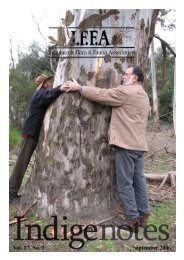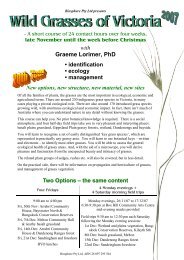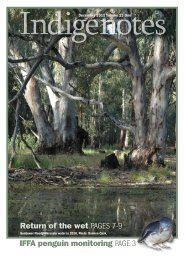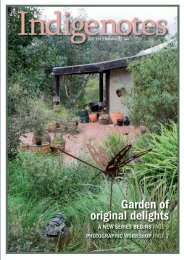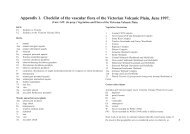Threatened Species Management Plan for Kinglake National Park
Threatened Species Management Plan for Kinglake National Park
Threatened Species Management Plan for Kinglake National Park
Create successful ePaper yourself
Turn your PDF publications into a flip-book with our unique Google optimized e-Paper software.
<strong>Threatened</strong> <strong>Species</strong> <strong>Management</strong> <strong>Plan</strong> <strong>for</strong> <strong>Kinglake</strong> <strong>National</strong> <strong>Park</strong>, – V 1.0, September 2001<br />
predation (particularly by foxes). Invertebrate food resources are also likely to be greatly reduced <strong>for</strong><br />
several years due to reduction of old, peeling bark and rotting tree stumps.<br />
The Brush-tailed Phascogale has also declined at the One Tree Hill and Rifle Range Reserves<br />
(Northern Reserves) to the south since fuel reduction burns were conducted there in 2005-06<br />
(reduction in trapping rates of up to 80%). These findings suggest that the species is extremely fire<br />
sensitive. Considering that the Northern Reserves and <strong>Kinglake</strong> <strong>National</strong> <strong>Park</strong> support up to 30% of<br />
the north-east Melbourne population (the most genetically diverse population in Victoria), the<br />
species is likely to have been greatly impacted across its range.<br />
It is recommended that further trapping sites be established within <strong>Kinglake</strong> <strong>National</strong> <strong>Park</strong> in burnt<br />
and unburnt sections, to monitor population recovery. This would also allow research to be<br />
undertaken to gain a greater understanding on the effect of fire on the species. Further trapping sites<br />
should be established in the southern Everard Block, in areas that were not burned in 2009.<br />
This project should be undertaken by <strong>Park</strong>s Victoria and DSE staff.<br />
6.1.6 Pitfall Trapping – establish pitfall lines to allow survey <strong>for</strong> small mammals<br />
and reptiles<br />
Several pitfall lines should be established throughout the <strong>Park</strong> to allow continual survey and<br />
monitoring of small mammals and reptiles. Pitfall lines would be particularly effective <strong>for</strong> surveying<br />
<strong>for</strong> Eastern Pygmy Possum, a species that is of localised occurrence within the <strong>Park</strong>. The 2006 and<br />
2009 fire burnt much of the known habitat of this species and a survey to determine its current<br />
distribution is greatly needed. The Hairpin Banksia, which is a key component of their habitat, was<br />
greatly depleted by the fires.<br />
The surveys should follow-up and build on previous pitfall surveys that have been undertaken<br />
within the <strong>Park</strong> (such as at Broad Gully and around Candlebark Track) by establishing new lines at<br />
these locations. Other sites that could be established should include along Captains Creek Road and<br />
Ninks Road (two sites from where the Eastern Pygmy Possum has been recorded) and at Stuart’s<br />
Spur.<br />
This project could possibly be undertaken by an educational group with assistance from <strong>Park</strong>s<br />
Victoria staff and regional experts.<br />
6.1.7 Targeted butterfly surveys – conduct survey <strong>for</strong> butterfly species in 2012<br />
The <strong>Park</strong> supports a high diversity of rare butterfly species, including the nationally threatened<br />
Small and Large Ant Blue Butterflies. Some butterfly species were possibly badly impacted by the<br />
2009 fire. The key food plant of the Macleay’s Swallow Tail, Southern Sassafras, was killed<br />
throughout most of its range, whilst the known sites <strong>for</strong> the Small and Large Ant Blue Butterflies<br />
were burnt at extreme intensities. However the fire may also have a positive effect on some species,<br />
and the early succession stages offer a rare opportunity to undertake a comprehensive assessment of<br />
butterfly populations within the <strong>Park</strong>. Broad Gully supports ideal habitat <strong>for</strong> the rare Chaostola<br />
Skipper, a species that is often conspicuous in the early years following a fire event.<br />
A detailed butterfly survey should be conducted in 2012 after the vegetation has recovered<br />
sufficiently. The survey should include particular focus at Broad Gully (a known butterfly hotspot)<br />
and in other areas of the <strong>Park</strong> considered to support suitable habitat. The study should have<br />
particular focus on Sedge skipper butterflies (that breed on Gahnia sp.) and should target rare species<br />
that have previously been recorded within the <strong>Park</strong> (see Beardsell 1997)<br />
22


